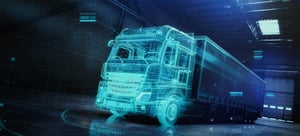Digital Twins for Logistics Optimization
When the topic of digital twins comes up within the supply chain, it is often in relation to warehouse management and optimization. Digital twins are an impressive piece of technology that can optimize your warehouse operation, but what gets left out of those conversations is how this technology can be utilized for other areas of the supply chain, such as transportation and logistics. Read on to see how digital twins can transform your transportation operations.
Key Takeaways:
-
Digital twins are digital duplicates of real-world assets, which are used to predict how a real object would react when changes are made to it
- In the supply chain and logistics, they can be used to simulate picking and packing, wear and tear on vehicles, options for network optimization, test location placement
What is a Digital Twin
Digital twins are a virtual replication of a physical object, or collection of objects, that use real-world, real-time data to best predict how the real object would react when changes are made to it. This allows supply chain professionals to save time and money by letting them see how various changes would impact their operation without the need for any initial implementation.
When digital twins are brought up in conversations about their usefulness in the supply chain, it is common for these discussions to pertain solely to warehouse optimization. Digital twins can be used for a number of warehouse optimization techniques, such as simulating the effects of different technologies or equipment, different warehouse layouts, and flow-throughs, different systems and sustainability measures, and much more.
Digital Twins for Logistics
However, digital twins are useful for far more than just your business’ warehouse operations. When it comes to the realm of transportation and logistics, this technology can provide a lot of value.
Picking and Packing Simulation
The global e-commerce market is enormous, with e-commerce in the US alone reaching an estimated $768 billion in 2021, according to Statista. Companies are always looking for more efficient and cost-effective packaging to ship their goods in. At the same time, customers are demanding more sustainable packaging as climate concerns increase.
Digital twins offer the ability for customers to simulate various different packaging solutions, and put them under various conditions like humidity, pressure, and vibrations to test how they hold up to the requirements of their particular products and transportation conditions.
Companies that utilize IoT solutions to bring their actual data into their digital twins to ensure the most realistic results when simulating their operation specifically.
Mechanical and Maintenance Simulation
Wear and tear on transportation vehicles can create increased costs for your transportation operation, not only in maintenance but also with any disruptions that these mechanical issues could create.
A digital twin of the vehicles and shipping containers that your operation uses can allow you to recreate the common conditions they are under to see where wear and tear are most common. This allows you to identify any crucial areas of weakness. If your operation uses truck transport, the common wear and tear on your vehicles would look different if you mostly drive in areas of high heat, rather than cold climates. The same would be true for areas deep inland versus being close to the coast where the humidity may be higher.
Network Simulations
An entire supply chain and logistics network is made up of a multitude of processes and partners. Orchestration of such a network can be error-prone and time-consuming with regards to data collection, analysis, and communication between these partners.
Combined with several management solutions, such as a TMS, WMS, and YMS, data from various partners, across wide distances, throughout the various stages of the supply chain, can be fed into a digital twin. This gives companies an overall, holistic view of your supply chain with up-to-date data that can make optimization and simulation much faster, less error-prone, and more efficient than ever before.
Stress and Resiliency Simulations
No longer do companies have to undergo actual stresses and hardships in order to learn how to be better resilient in the face of local and global supply chain challenges.
Digital twins allow supply chain managers to easily simulate likely, and even unlikely challenges to their operations.This enables them to test their current resiliency, as well as identify any weak areas in order to improve resiliency in case these disruptions happen in the real world. This helps to improve responsiveness so that the negative effects of any challenges, such as extreme weather phenomena, global pandemics, or infrastructure collapse, are kept to a minimum.
Physical Location Placement
Scalability and responsiveness to fluctuations in the market are crucial for the success of a supply chain operation. The placement of your facilities and the support systems of your network can impact the effectiveness of getting your goods to your customers. With digital twins, you can alter the placement of your facilities and support systems to see how various locations respond to both increases and decreases in supply and demand to identify ideal placement.
Conclusion
The technology behind digital twins is ever-advancing and creating more and more opportunities for supply chain professionals to get ahead of the game and identify areas where they can save time and money, improve customer satisfaction, and improve partner relationships.




